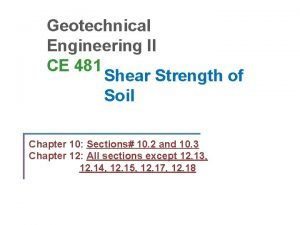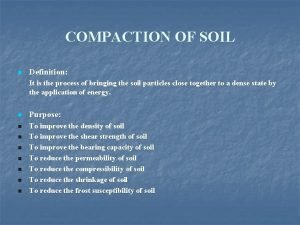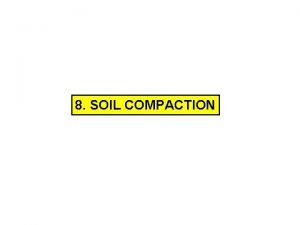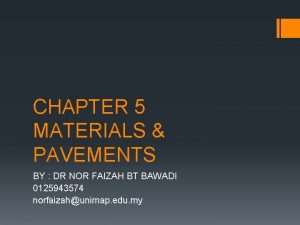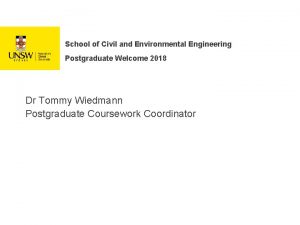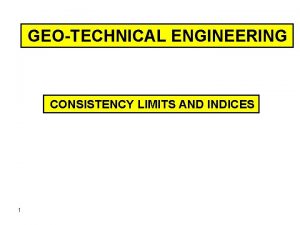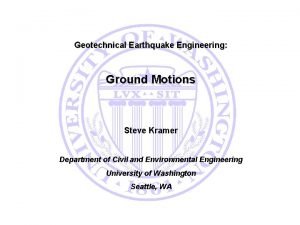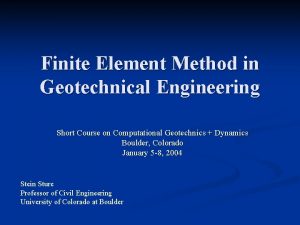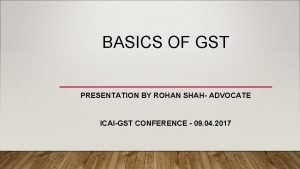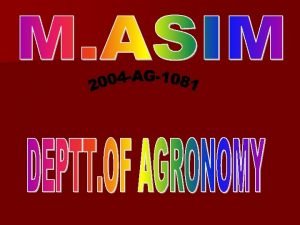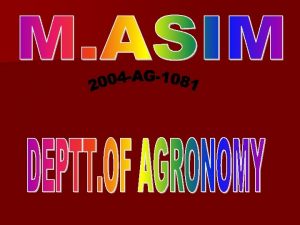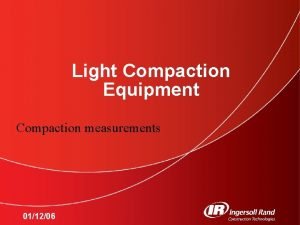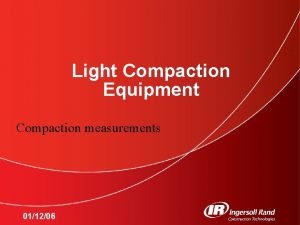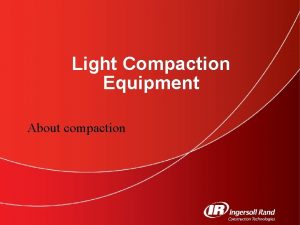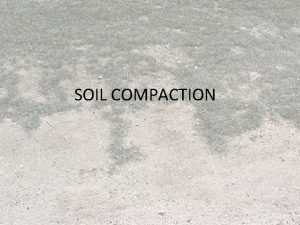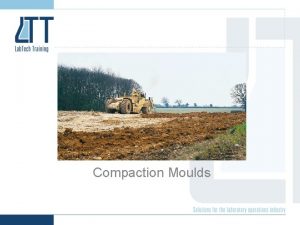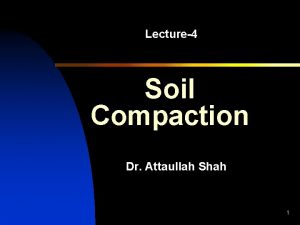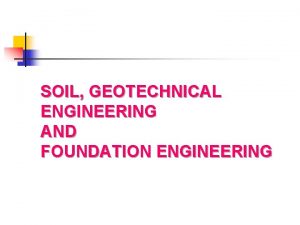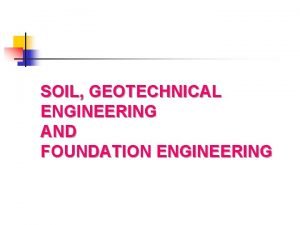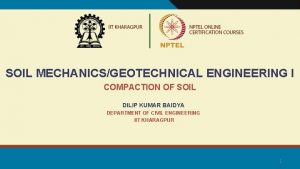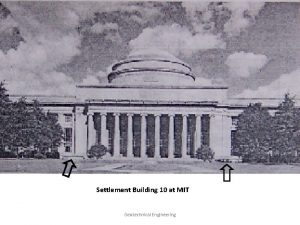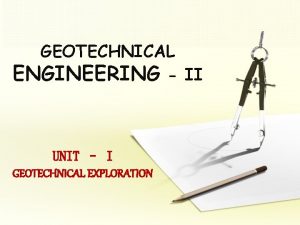Geotechnical Engineering Compaction Of Soil Mr Rohan Dashupta



















- Slides: 19

Geotechnical Engineering: Compaction Of Soil Mr. Rohan Dashupta, Asst. Professor Department: B. E. Civil Engineering Subject: Geotechnical Engineering - I Semester: V e. Courseware@AIKTC

INTRODUCTION Compaction is the process in which a stress applied to a soil causes densification. Air is displaced from the pores between the soil grains. Normally, compaction is the result of heavy machinery compressing the soil, but it can also occur due to the passage of (e. g. ) animal feet.

INTRODUCTION Soil compaction is a vital part of the construction process. It is used for: • building foundations, • roadways, • walkways, • earth retaining structures etc. For a given soil type certain properties may deem it more or less desirable to perform adequately for a particular circumstance. To ensure adequate soil compaction is achieved, project specifications will indicate the required soil density or degree of compaction that must be achieved. These specifications are generally recommended by a geotechnical engineer.

INTRODUCTION

STANDARD PROCTOR TEST The Standard Proctor Compaction Test is a laboratory method of experimentally determining the optimal moisture content at which a given soil type will become most dense and achieve its maximum dry density. Reference to Indian Standards: IS : 2720 (Part 7) -1980

STANDARD PROCTOR TEST: APPARATUS RAMMER Dia: 50 mm Weight: 2. 6 kg Arrangement to control the height of drop to a free fall of 310 mm PROCTOR MOULD Capacity: 1000 ml Int. Dia. : 100 mm Ext. Dia. : 116 mm Height: 127. 3 mm Detachable Collar Assembly Detachable Base Plate

STANDARD PROCTOR TEST: PROCEDURE 1. 5 kg. of soil is taken and the water is added to it to bring its moisture content to about 4 % in coarse grained soils and 8% in case of fine grained soils with the help of graduated cylinder. 2. The mould with base plate attached is weighed to the nearest 1 gm (M 1). The extension collar is to be attached with the mould. 3. Then the moist soil in the mould is compacted in three equal layers, each layer being given 25 blows from the 2. 6 Kg rammer dropped from a height of 310 mm. above the soil. 4. The extension is removed and the compacted soil is levelled off carefully to the top of the mould by means of a straight edge. 5. Then the mould and soil is weighed to the nearest 1 gm. (M 2). 6. The soil is removed from the mould and a representative soil sample is obtained water content determination. 7. Steps 3 to 6 are repeated after adding suitable amount of water to the soil in an increasing order.

STANDARD PROCTOR TEST: CALCULATION Bulk density ρ in gm/cm 3 for each compacted specimen is calculated from the equation ρ = ( M 2 - M 1 ) / V m where Vm is the volume of mould in cm 3 The dry density ρd, in gm/cm 3 is calculated from the equation ρd = (100 * ρ) / (1 + w) where w is the moisture content of the soil in percent. The dry densities, ρd obtained in a series of determinations are plotted against the corresponding moisture content w. A smooth curve is then drawn through the resulting points and the position of the maximum on this curve is determined.

STANDARD PROCTOR TEST: CALCULATION gdry max Optimum Water Content


MODIFIED PROCTOR TEST or HEAVY COMPACTION TEST ture c e l n i l i eta d n i d e s ~ discus ~

FACTORS AFFECTING COMPACTION 1. 2. 3. 4. 5. Water Content Amount of Compaction Method of Compaction Type of Soil Addition of Admixtures ere~~ r u t c e l u t n il in lec a t e d a t n i e ed n d ~~ddisicsucussssed i

FIELD COMPACTION METHODS Rolling Ramming (by impact) Vibration

FIELD COMPACTION METHODS: ROLLING EQUIPMENTS Smooth Wheel Roller

FIELD COMPACTION METHODS: ROLLING EQUIPMENTS Pneumatic Type Roller

FIELD COMPACTION METHODS: ROLLING EQUIPMENTS Sheep Foot Roller

FIELD COMPACTION METHODS: RAMMING EQUIPMENTS

FIELD COMPACTION METHODS: VIBRATINGING EQUIPMENTS

Thank you!
 Consolidated drained triaxial test example
Consolidated drained triaxial test example Define compaction of soil
Define compaction of soil Soil compaction test
Soil compaction test Soil structure ppt
Soil structure ppt Soil compaction
Soil compaction Gsoe9220
Gsoe9220 Applied geotechnical engineering
Applied geotechnical engineering Consistency limits in geotechnical engineering
Consistency limits in geotechnical engineering Geotechnical engineering
Geotechnical engineering Geotechnical earthquake engineering kramer
Geotechnical earthquake engineering kramer Fem geotechnics
Fem geotechnics Construction management swinburne
Construction management swinburne Rohan chabukswar
Rohan chabukswar Rohan byanjankar
Rohan byanjankar Rohan schaap
Rohan schaap Rohan shah advocate
Rohan shah advocate Sindrome de rohan
Sindrome de rohan Twitter api rss
Twitter api rss Biografia de john kenneth turner
Biografia de john kenneth turner Rohan hall urologist
Rohan hall urologist
